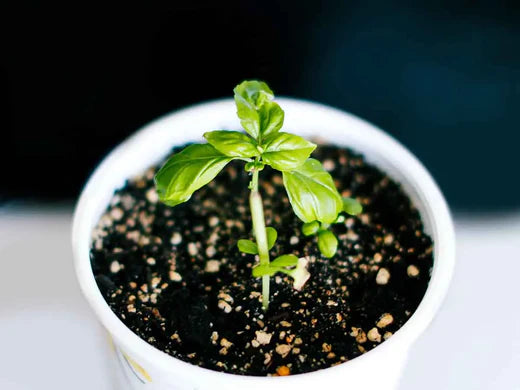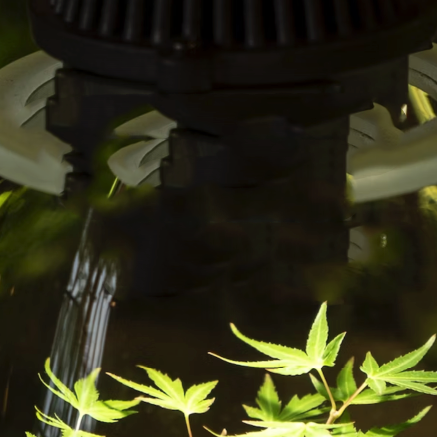OK, nobody is going to dispute this... learning to grow can have a very steep initial learning curve. There are all sorts of things that a newbie needs to learn during his or her first grow. But don't worry... To reduce the likelihood of a catastrophe, here's a list of the ten most common issues that newbies encounter.
1) Over-watering your plants
Plants need water. The problem is that, armed with this information and believing that if a bit of something is good then lots must be better, many people water their plants much too frequently. This is particularly bad news when plants are potted in a water retentive medium, such as soil.
Yes, plants need water, but roots also need oxygen. Drowning them not only starves them of oxygen but also creates the ideal conditions for root-rot. Fabric pots, like the RhizoPot, help a lot and they're a better choice than solid plant pots because their breathable fabric naturally helps to increase oxygenation.
Allowing the medium to dry out a little in-between waterings will deliver the oxygen that plants need while helping to avoid the dreaded root-rot. This is less important for hydroponic grow systems, but in soil your plants shouldn't need watering too often to start off with.
You can judge how wet the soil is by something called the heft test. Learn how heavy your pots of soil are when wet, and also how heavy they are when they are getting a little dry. Only water when the pots are getting lighter. Balance is obviously key here, and you should never let the soil dry out completely.
2) Too much or too little feed
Plants obviously need food but, like water, excessive feeding can be more detrimental than underfeeding. An overfed plant will become sick very quickly and can even die.
Feed charts can serve as guides, giving you some indication of the right dosages to shoot for. However, as you progress through your indoor growing journey, you'll learn to judge things yourself using testing equipment. We stock a wide range of products that will help you to gauge nutrient strength, from measuring equipment to conductivity meters.
3) Light heights – too high or too low
Plants like lots of light, but too much of anything can be a bad thing, and it's therefore crucial to avoid causing stress by using grow lighting at appropriate heights.
LED grow lights are much more efficient than HID grow light systems (like HPS and metal halide) and are less likely to cause heat stress. Never the less, it's still possible to stress plants by placing the grow light too close to the canopy.
Always start with the light raised up and on a lower setting, working it down gradually and increasing the output level as your plants get settled in. Look for signs of stress and make adjustments to the output as required.
At the same time, keeping your light too far away from plants will reduce rates of photosynthesis and impact yields. As always, finding the right balance is key, and this is a skill that naturally develops over time.
4) Air temperature – too hot or too cold
The maximum daytime temperature that's comfortable for typical indoor plants is generally around 28°C. Aim for temperatures of around 26°C during daylight hours and 18°C during dark periods.
A decent hygrometer will keep you informed on grow room temperatures as well as humidity levels (more on that later). If you need to raise the temperature level, take a look at our range of heaters.
5) Inadequate extraction
This is a classic newbie mistake. People new to growing often believe that they will get along fine if they scrimp on the extraction system. Some people even try to start growing without one at all!
Plants depend on the CO2 in the surrounding air, which they will quickly use up. Once the CO2 is depleted, they will no longer be able to photosynthesize and will stop growing. The air inside a grow tent or grow space needs to be replaced roughly once every two minutes, so be sure to spec an extraction system that's got enough airflow
6) Not checking for pests
Failing to regularly check for pests can quickly turn a thriving grow tent into a disaster zone. Even minor infestations can spread rapidly, damaging plants and reducing yields. Inspect your garden frequently for early signs of pests, such as discoloured leaves, small holes, or visible insects. Use preventative measures like sticky traps and beneficial insects, and always act fast to control any outbreaks before they escalate. Staying vigilant keeps your grow pest-free and productive.
7) pH problems
This problem tends to affect mineral-based feeds more than organics. At incorrect pH levels, certain nutrients can precipitate out of mineral-based solutions or become chemically unavailable to plants, leading to nutrient deficiencies or imbalances. Organic feeds, on the other hand, often buffer pH naturally through microbial activity, making them less susceptible to these issues.
In a hydroponic grow system, maintaining the nutrient solution within a pH range of 5.5 to 6.0 – ideally around 5.8 – is essential for optimal plant health.
Equip yourself with a reliable pH meter and pH down solution to regularly monitor and adjust your nutrient water, keeping it in the ideal range to promote vigorous growth and overall plant well-being.
The ideal pH for soil 6.5 to 6.8. When you have watered your plants and collected some run off in the saucer beneath, use a pH meter to make sure the levels are staying within acceptable limits.
8) Incorrect humidity
Plants need a relative humidity (RH) of between 60% and 70% when vegging and around 50% during flowering / fruiting. Humidity levels too far out of these ranges will cause slowed growth or vulnerabilities to mould.
Use your extraction system or dehumidifier to help keep humidity down, or a humidifier to help raise it. Keep RH in the right range and your plants will thank you!
9) No temperature difference between light and dark cycles
Plants sense when it's time to flower based on the number of daylight hours, but something else that they are sensitive to is the temperature difference between day and night.
During the flowering phase, when maintaining daytime temperatures of around 25-28°C, try to ensure make sure that the temperature drops by at least 5°C when the lights go out. Your plants will flower / fruit more quickly and more plentifully if you do!
The memory function on our trusty hygrometers will help you to track night-time temperature lows.
10) Not talking to your plants
OK, that was a little joke. We're not actually proposing that you go and chat to them about what has just happened on Corrie. However, plants definitely respond to the time you spend tending them and the care that you give them. The more, the better. Love your plants and they will give it back to you come harvest time!

